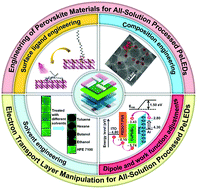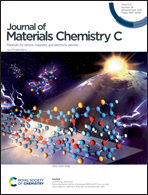The solution-processed fabrication of perovskite light-emitting diodes for low-cost and commercial applications
Abstract
Metal halide perovskite light-emitting diodes (PeLEDs) have emerged as some of the most promising candidates for next-generation high-resolution displays due to their wide color gamut, high color purity, and low-cost solution processability. After just a few years of research, the external quantum efficiencies (EQEs) have exceeded 20% for PeLEDs based on the vacuum evaporation of charge transport layers (CTLs) upon perovskite layers. The use of all-solution-processed deposition to produce PeLEDs could further simplify fabrication procedures, lower processing costs, and enhancing compatibility with flexible substrates. However, the EQEs do not exceed 7% for these PeLEDs because perovskites are sensitive to many solvents due to their ionic nature. Moreover, colloidal perovskite quantum dots (PeQDs) easily dissolve in polar and non-polar solvents because of their surface organic ligands. In this perspective, we first briefly introduce the crystal structures and intrinsic instability of metal halide perovskites making them unsuitable for solution-processed deposition, and then summarize recent advances relating to all-solution-processed PeLEDs. Finally, the challenges and outlooks for the future development of all-solution-processed PeLEDs are discussed.



 Please wait while we load your content...
Please wait while we load your content...